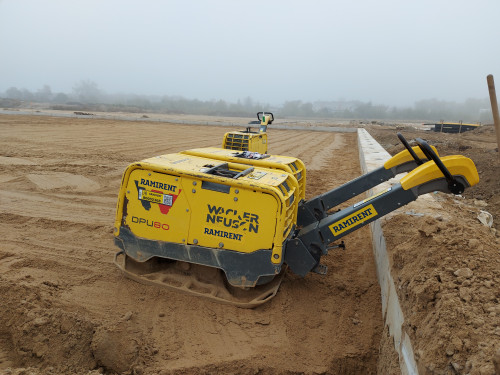Can a compactor be used on wet ground?
A compactor is an indispensable tool for many construction and roadworks, especially where compaction of ground, gravel, sand or other loose materials is required. In this article, we explain whether it can be used on wet ground and what determines its effectiveness.

Effect of wet ground on compactor performance
Wet soil can pose a challenge during compaction work. Water in the soil alters the properties of the soil and can therefore hinder effective compaction. On a wet surface, the soil becomes more plastic, which means that the compaction force may not work as effectively as on dry soil.
Compaction force on wet soil:
- Water in the soil makes the material particles sticky, which reduces the compaction force.
- On wet ground, more passes of the compactor may be required to achieve the desired effect.
Soil type versus compactor performance:
- Clay soil, which absorbs water and becomes muddy, is more difficult to compact.
- Wet sand is easier to compact, but requires sufficient compactor power. In this case, hiring a more powerful compactor may be necessary.
Which compactors will work well on wet ground?
Compaction of wet soil requires the right choice of equipment, as not every model will cope with the harsh conditions. Vibration force, the weight of the equipment and the type of compaction mechanism are key here. Construction equipment rental company Ramirent has various models of compactors available for hire that will work well in such conditions:
1.Diesel vibratory rammers - for difficult and sandy areas
Vibratory rammers are the best solution for working on very wet and clayey ground. Thanks to their concentrated impact force, they work well in hard-to-reach areas such as trenches or narrow spaces.
2.Reversible compactors - for larger areas
For larger areas and more demanding conditions, reversible vibratory plates are the perfect choice, as their heavier weight and bi-directional movement ensure better compaction of wet ground. Depending on the specific terrain, it is worth choosing:
- Compaction models 150 - 250 kg - suitable for moderately wet soil, e.g. on construction sites and paving.
- Reversible compactors 450 - 550 kg - effective for compacting wet sand and clay, used for foundations or roadworks.
- The heaviest reversible vibratory plates 650 - 740 kg - designed for extremely difficult conditions, including wet and boggy pavements, where deep and intensive compaction is required.
3. Unidirectional vibratory plates - for lighter work.
For work on slightly damp surfaces, single-directional compactors (50 - 120 kg) can be used and are suitable for compacting sand, sub-base or laying kerbs. However, they are not recommended for very wet and soggy areas where more compaction force is needed.
Need to hire a compactor for your project? Contact Ramirent Construction Equipment Rental in Olsztyn and our spec